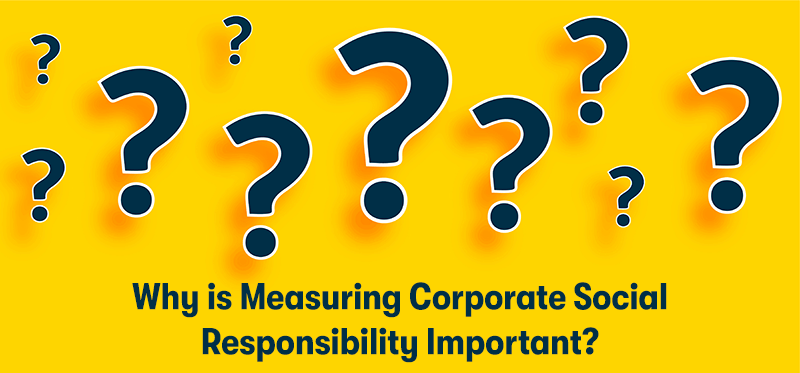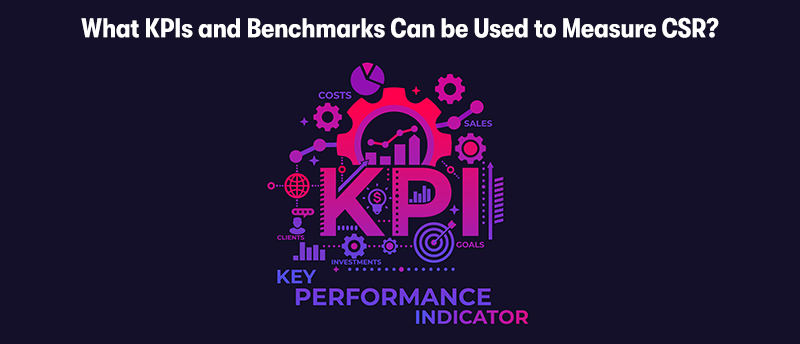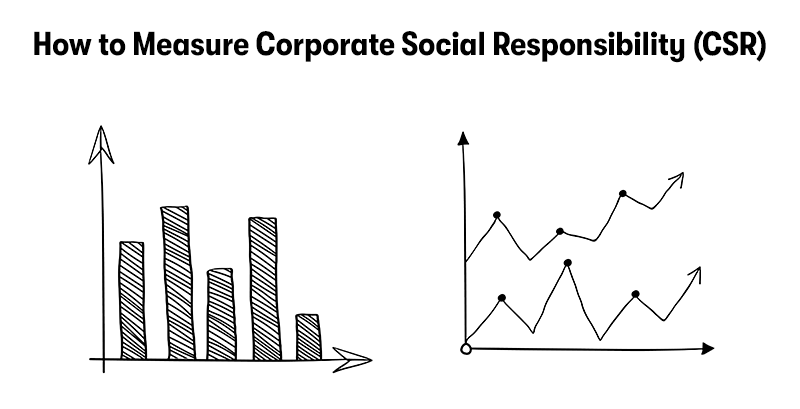How to Measure Corporate Social Responsibility (CSR)
In an era where sustainability and ethical conduct are at the forefront of corporate agendas, measuring Corporate Social Responsibility (CSR) has become paramount for businesses seeking to validate their commitment to social, environmental, and economic stewardship.
As stakeholders demand greater transparency and accountability, the challenge for companies lies in quantifying their CSR efforts effectively. This exploration delves into the methodologies and metrics essential for assessing CSR initiatives, providing a comprehensive guide for organisations aiming to navigate the complexities of responsible business practices.
From sustainability reporting to ESG metrics and beyond, we unravel the intricacies of CSR measurement, offering insights into how companies can track their progress and leverage their CSR endeavours to foster a positive impact on society and the environment.
How to Measure Corporate Social Responsibility
Measuring Corporate Social Responsibility involves assessing a company's efforts and impacts in areas related to ethical, social, environmental, and economic responsibilities. Here are several ways to measure CSR:
Sustainability Reporting
Many companies publish annual sustainability or CSR reports that detail their practices and impacts on the environment, society, and economy. These reports often follow global standards such as the Global Reporting Initiative (GRI), which provides a framework for reporting on various sustainability metrics.
ESG (Environmental, Social, and Governance) Metrics
ESG criteria are standards for a company's operations that socially conscious investors use to screen potential investments. Environmental criteria consider how a company performs as a steward of nature. Social criteria examine how it manages relationships with employees, suppliers, customers, and communities. Governance involves a company's leadership, executive pay, audits, internal controls, and shareholder rights.
Certifications and Ratings
Certifications like ISO 26000 (guidance on social responsibility), B Corp Certification (for businesses that meet high standards of social and environmental performance, accountability, and transparency), and LEED certification (for green buildings) can serve as indicators of a company's commitment to CSR. Additionally, ESG ratings provided by agencies such as MSCI, Sustainalytics, and others offer insights into a company's social and environmental performance.
Stakeholder Feedback
Engaging with stakeholders (employees, customers, investors, communities, etc.) through surveys, interviews, and forums can provide qualitative and quantitative data on the company's CSR performance and impact.
Social Impact Assessment
Measuring the direct and indirect social impacts of a company's operations, projects, or initiatives. This can include assessing how the company contributes to community development, employee well-being, and other social goals.
Environmental Impact Assessment
Evaluating the environmental effects of a company's operations, such as carbon footprint, water usage, waste management, and biodiversity impacts. This can involve both qualitative assessments and quantitative measures like greenhouse gas emissions and resource consumption.
Benchmarking
Comparing a company's CSR efforts and performance against industry peers or best practices to identify areas of strength and opportunities for improvement.
Social Return on Investment (SROI)
A method for measuring extra-financial value (i.e., environmental and social value not currently reflected in conventional financial accounts) relative to resources invested. It provides a framework for measuring and accounting for this much broader concept of value.
Third-party Audits and Reviews
Independent assessments by external auditors or reviewers can provide an unbiased view of a company's CSR performance and adherence to social and environmental standards.
Each of these methods can provide valuable insights into a company's CSR efforts, but they are most effective when used together to give a comprehensive view of performance. The choice of metrics and methods depends on the company's specific CSR goals, the industry sector, and stakeholder expectations.
Why is Measuring Corporate Social Responsibility Important?

Measuring Corporate Social Responsibility is crucial for several reasons, impacting not just the companies involved but also society, the environment, and the economy at large. Here are key reasons why measuring CSR is essential:
Transparency and Accountability
Measuring CSR helps ensure companies are transparent about their operations and impact on society and the environment. It holds them accountable to their stakeholders, including customers, employees, investors, communities, and regulators, by providing evidence of their efforts and outcomes in addressing social, environmental, and ethical issues.
Improved Decision-Making
Companies can obtain valuable data to inform their decision-making processes by systematically measuring their CSR activities. This can lead to better resource allocation, identifying areas for improvement, and developing strategies that align with both business objectives and societal values.
Stakeholder Trust and Reputation
Demonstrating a commitment to CSR through measurable outcomes can significantly enhance a company's reputation. It builds trust with stakeholders by showing that the company is not only focused on profit but also contributes positively to society and the environment. This trust can lead to increased customer loyalty, easier recruitment of top talent, and stronger relationships with communities and governments.
Risk Management
Measuring CSR activities helps companies identify and manage risks related to social and environmental issues. For instance, a company that actively monitors its environmental impact is better positioned to anticipate and respond to regulatory changes, environmental disasters, or resource scarcity. This proactive approach can mitigate risks that could otherwise lead to financial losses or damage to the company's reputation.
Competitive Advantage
Companies that effectively measure and report on their CSR efforts can differentiate themselves from competitors. This can be a significant advantage in markets where consumers, clients, and partners prioritise sustainability and ethical practices. It can also attract socially responsible investments.
Compliance and Legal Requirements
Many regions have increasing legal and regulatory requirements related to sustainability and corporate responsibility. Measuring CSR activities helps companies ensure compliance with these laws, avoiding fines and legal challenges.
Enhanced Financial Performance
A growing body of evidence suggests that strong CSR practices can positively impact a company's financial performance when adequately measured and implemented. This can be through operational efficiencies, such as reduced waste and energy costs, or through increased revenue from consumers who prefer to buy from socially responsible companies.
Long-term Sustainability
Measuring CSR is critical for assessing and ensuring the long-term sustainability of a company. It helps companies understand the impacts of their operations on the environment and society and develop strategies that promote long-term health and viability for both the business and the planet.
In summary, measuring CSR is not just about fulfilling ethical obligations or regulatory requirements; it's also a strategic business practice that can lead to significant benefits, including improved reputation, competitive advantage, and financial performance. It underscores a shift towards more sustainable and responsible business practices that consider the well-being of all stakeholders, including the planet.
What KPIs and Benchmarks Can be Used to Measure CSR?

Key Performance Indicators (KPIs) and benchmarks are essential tools for measuring the effectiveness of Corporate Social Responsibility initiatives. They help organisations track progress, evaluate outcomes, and make informed decisions. Here are some commonly used KPIs and benchmarks for assessing CSR performance across various dimensions:
Environmental Sustainability
Carbon Footprint: Measures the total greenhouse gas emissions caused directly and indirectly by an organisation.
Energy Consumption: Tracks the energy used, promoting efforts to reduce energy use and increase efficiency.
Water Usage: Quantifies the volume of water used, encouraging water conservation and implementing sustainable water management practices.
Waste Management: Evaluate the amount of waste generated and the effectiveness of waste reduction, recycling, and reuse policies.
Social Responsibility
Employee Engagement and Satisfaction: Surveys and metrics that assess employee morale, engagement, and job satisfaction.
Diversity and Inclusion: Measures the diversity of the workforce and leadership in terms of gender, ethnicity, age, and other factors, as well as policies and practices that promote inclusivity.
Community Impact: Assesses the impact of community engagement initiatives and philanthropic efforts, including volunteer hours, donations, and support for local projects.
Health and Safety: Tracks workplace accidents, injuries, and occupational illnesses to ensure a safe working environment.
Governance and Ethics
Compliance: Measures adherence to local, national, and international laws and regulations, including labour, environment, and corporate governance.
Ethical Sourcing: Evaluates the extent to which a company ensures its supply chain practices are ethical, including labour rights and environmental standards.
Data Protection and Privacy: Tracks compliance with data protection laws and the effectiveness of cybersecurity measures.
Transparency and Reporting: Assesses the quality, comprehensiveness, and frequency of sustainability and CSR reporting, including adherence to international standards like GRI.
Economic Performance
SROI (Social Return on Investment): Calculates the social, environmental, and economic value a CSR initiative creates relative to the resources invested.
Economic Impact: Measures the company's direct and indirect economic impact on its local and global communities, including job creation and economic development.
Innovation in Sustainability: Tracks investments in sustainable technologies and innovations that aim to reduce environmental impact or improve social outcomes.
Benchmarks for Comparison
To contextualise these KPIs, companies often compare their performance against:
Industry Standards and Averages: Comparing CSR metrics with industry peers to gauge relative performance.
Historical Performance: Tracking progress over time to assess improvement in CSR initiatives.
Best Practices and Leadership Standards: Evaluating performance against recognised leaders in CSR and sustainability to identify improvement areas and innovation opportunities.
Global Frameworks and Indices: Utilising frameworks like the United Nations Sustainable Development Goals (SDGs) or indices such as the Dow Jones Sustainability Index (DJSI) for benchmarking against global sustainability goals and top-performing companies.
Selecting the right KPIs and benchmarks depends on the company's specific CSR objectives, industry sector, and stakeholder expectations. It's also important for companies to regularly review and adjust their KPIs to reflect changing priorities, challenges, and opportunities in their CSR strategy.
What is Digital Sustainability?

Digital sustainability refers to the practice of designing, using, and disposing of technology in a way that supports environmental, social, and economic sustainability goals. It encompasses a broad range of activities and principles aimed at reducing the negative impacts of digital technology on the planet and society while also leveraging these technologies to create positive sustainability outcomes. Digital sustainability is increasingly recognised as a critical component of broader sustainability efforts, given the significant environmental footprint of the digital sector and the potential for digital innovations to address global sustainability challenges.
Key Aspects of Digital Sustainability
Energy Efficiency of Digital Systems: This includes optimising data centres, networks, and devices to consume less energy and utilise renewable energy sources, thereby reducing the carbon footprint associated with digital operations.
Resource Efficiency and E-waste Management: It involves designing products with longer lifecycles, promoting the repairability and recyclability of electronic devices, and implementing responsible e-waste disposal and recycling practices to minimise the environmental impact of digital hardware.
Sustainable Software Engineering: This aspect focuses on developing software requiring less computational power and energy consumption, making digital services more sustainable.
Digital Inclusion: Ensuring equitable access to digital technologies and the benefits they offer, addressing the digital divide, and empowering all segments of society to participate in the digital economy.
Leveraging Digital Innovations for Sustainability: Using digital technologies, including big data, artificial intelligence (AI), and the Internet of Things (IoT), to drive sustainability in various sectors such as agriculture, energy, transportation, and manufacturing. This can include optimising resource use, enhancing energy efficiency, and enabling more sustainable consumption patterns.
Challenges and Opportunities
Challenges: The digital sector's rapid growth poses significant sustainability challenges, including high energy consumption, increasing e-waste, and the use of hazardous materials in electronic devices. Additionally, there's the issue of the digital divide, where unequal access to digital technologies exacerbates social and economic inequalities.
Opportunities: Digital technologies offer unprecedented opportunities to address global sustainability challenges. Smart grids can enhance energy efficiency, precision agriculture can reduce water and chemical use, and AI can optimise resource allocation across numerous sectors. Moreover, digital platforms can foster a more circular economy by facilitating the sharing and recycling of goods.
Moving Forward
Achieving digital sustainability requires collaborative efforts among governments, businesses, civil society, and consumers. Policies and practices that promote the development and use of green technologies encourage sustainable consumption habits and ensure inclusive access to digital benefits are essential. Additionally, research and innovation in green computing, sustainable software design, and digital solutions for sustainability challenges will play a crucial role in advancing digital sustainability.
Where Can You Learn More About Digital Sustainability?
At Purple Griffon, we offer an ITIL® 4 Specialist Sustainability in Digital & IT (SDIT) training course. This course will help you to:
- Understand how to use the ITIL guiding principles to deliver value by creating sustainable digitally enabled products and services.
- Effectively address VUCA challenges through sustainable strategies, procurement, products and practices.
- Obtain a practical grounding in the key principles of sustainability.
- Conduct a complete cost-benefit analysis identifying potential risks and opportunities using best practice guidance.
Final Notes on Measuring Corporate Social Responsibility
In conclusion, our exploration of Corporate Social Responsibility underscores its critical role in today's business landscape, emphasising the importance of measuring CSR through various KPIs and benchmarks to ensure transparency, accountability, and sustainable growth.
We delved into the significance of digital sustainability, highlighting the need for energy-efficient digital systems, responsible e-waste management, and the utilisation of technology in driving broader sustainability goals. As businesses and societies continue to navigate the complexities of sustainability, the integration of CSR and digital sustainability practices emerges as a pivotal strategy.
By fostering collaboration across sectors and embracing innovative solutions, we can advance towards a more sustainable and inclusive future, underscoring the imperative for conscientious stewardship in both the digital and physical realms.


